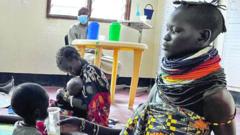The earthquake on March 28 not only claimed thousands of lives but also devastated the country's spiritual foundation as many monks and monasteries faced destruction.
**Devastating Earthquake in Myanmar: A Crisis for Communities and Monks Alike**

**Devastating Earthquake in Myanmar: A Crisis for Communities and Monks Alike**
A powerful earthquake has shaken Myanmar, resulting in heavy casualties and significant destruction of religious sites.
The people of Myanmar find themselves in mourning as a catastrophic earthquake struck on March 28, leaving thousands dead and widely affecting the country's Buddhist community. Amid the rubble, the sorrow resonates deeply, particularly among monks known for providing guidance and support during calamities. In a poignant scene last week, a group of mourners gathered to bid farewell to Ashin Pyinnyar Tharmi, a 27-year-old monk who perished when his monastery collapsed.
Wrapped in his maroon robe, Tharmi’s body was surrounded by fellow monks as they recited prayers for the deceased, expressing their grief through heartfelt chants. One monk, Ashin Javanar Linkhara, held Tharmi’s robe to his forehead, whispering a phrase steeped in Buddhist wisdom: “Impermanent, alas, are all formations.” This act of mourning was compounded by the grim reality of mass cremations taking place, contrasting with the traditional lengthy ceremonies often reserved for monks.
Prior to the earthquake, Myanmar was grappling with the fallout from prolonged civil strife, placing the nation in a humanitarian predicament. As the dust settles, the toll reveals itself not just in the lives lost—most notably the many monks whose spiritual leadership has been irrevocably impacted—but also in the destruction of thousands of cultural and religious sites. The full extent of the devastation, however, is yet unknown.
Amid the tragedy, the repercussions extend to the soul of Myanmar; with Buddhism as the nation's dominant faith embraced by approximately 90% of its citizens, the earthquake has struck at the core of its societal structure. Tragically, this earthquake may further strain community relations at a time when they are already fraught, following a surge in nationalist fervor and extremist behavior in recent years.
Wrapped in his maroon robe, Tharmi’s body was surrounded by fellow monks as they recited prayers for the deceased, expressing their grief through heartfelt chants. One monk, Ashin Javanar Linkhara, held Tharmi’s robe to his forehead, whispering a phrase steeped in Buddhist wisdom: “Impermanent, alas, are all formations.” This act of mourning was compounded by the grim reality of mass cremations taking place, contrasting with the traditional lengthy ceremonies often reserved for monks.
Prior to the earthquake, Myanmar was grappling with the fallout from prolonged civil strife, placing the nation in a humanitarian predicament. As the dust settles, the toll reveals itself not just in the lives lost—most notably the many monks whose spiritual leadership has been irrevocably impacted—but also in the destruction of thousands of cultural and religious sites. The full extent of the devastation, however, is yet unknown.
Amid the tragedy, the repercussions extend to the soul of Myanmar; with Buddhism as the nation's dominant faith embraced by approximately 90% of its citizens, the earthquake has struck at the core of its societal structure. Tragically, this earthquake may further strain community relations at a time when they are already fraught, following a surge in nationalist fervor and extremist behavior in recent years.



















